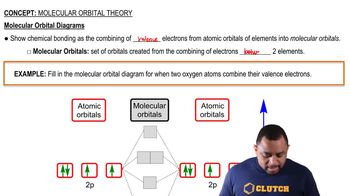Here are the essential concepts you must grasp in order to answer the question correctly.
Electron Shielding
Electron shielding occurs when inner-shell electrons repel outer-shell electrons, reducing the effective nuclear charge felt by the outer electrons. This phenomenon affects the energy levels of orbitals, as electrons in the same shell experience different levels of attraction to the nucleus based on their proximity to inner electrons.
Recommended video:
Orbital Energy Levels
In multielectron atoms, the energy levels of orbitals (such as 3s, 3p, and 3d) are influenced by both the principal quantum number and the angular momentum quantum number. The 3s orbital is lower in energy than the 3p, which in turn is lower than the 3d, due to differences in penetration and shielding effects, leading to distinct energy separations among these orbitals.
Recommended video:
Molecular Orbital Diagram
Penetration Effect
The penetration effect refers to how effectively an electron in a given orbital can get close to the nucleus, thereby experiencing a stronger attraction. s orbitals have the highest penetration, followed by p and then d orbitals. This difference in penetration contributes to the varying energy levels of the 3s, 3p, and 3d orbitals, as electrons in s orbitals are less shielded and thus lower in energy.
Recommended video:
 McMurry 8th Edition
McMurry 8th Edition Ch.6 - Ionic Compounds: Periodic Trends and Bonding Theory
Ch.6 - Ionic Compounds: Periodic Trends and Bonding Theory Problem 95
Problem 95 Verified step by step guidance
Verified step by step guidance


